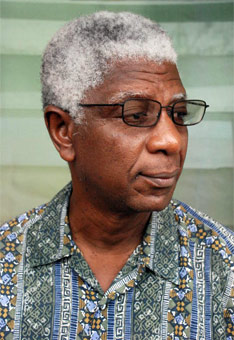El Anatsui in conversation with ArtInfo
Posted under Views on March 1st 2011

In 2010, ARTINFO called Anatsui in Nigeria, where he works as a sculpture professor at the national university, to discuss his practice, the element of chance in his work, and his favorite artists.
How long did it take for you to create each of the tapestries in the show?
That is a difficult question. There is how long the idea takes to come up with and analyze, and then there is how long it takes to realize. How long it takes to conceptualize can be really long. I work on several at the same time. Sometimes you're working on one, and you get stuck, you don't know where next to go, so you might start something else and keep that other one on the back burner for some time. When the right inspiration comes, you pick it up. But if you talk about just the fabrication, although I work with several hands — several assistants, at times 20, 25 — it can also be very long.
When you're conceptualizing an idea, where do you start?
Sometimes I think of a color. I'll want to do something in gold and silver, or in black, or in red. Usually I just let an idea take off and let it grow organically.
Do you do draw as you work out your ideas?
I never draw. The process is so slow that you don't need to draw. You have all the time you need to make corrections. It's unlike when you work with power tools like the chainsaw, which is very fast. Then, you need to know what you're going to do ahead of time. [laughs] Before you start the saw. But with these works there is lot of slack, lots of latitude and freedom.
When you're building a piece, how do you begin?
Usually the pieces are laid out on the floor, and then we start stitching it all together if one is satisfied with how it looks. Otherwise one can stop, cut some pieces out, and replace the pieces. If parts are finished but there are portions that don't look like, you can cut them out and replace them and keep shifting them until they feel right. Normally the project starts with maybe a two-foot-by-one-foot portion, then you keep expanding and expanding from there. You build out in different directions from there.
How do you know when you have finished?
There is the one work in the back of the gallery with a very interesting section that juts off of the tapestry, which is a bit different than the other works. I was building that piece out and I liked it like that, so I left it that way. I didn't want it to be rectangular. That piece was done using the backs of the bottle caps, which led to the very light-silver colors.








Comments
Leave your comment